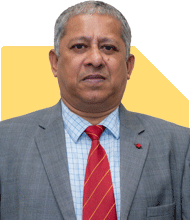How to invest wisely with high stock market exposure and a large car loan?
Ramalingam Kalirajan |8459 Answers |Ask -Follow
Mutual Funds, Financial Planning Expert - Answered on Aug 16, 2024
He has an MBA in finance from the University of Madras and is a certified financial planner.
He is the director and chief financial planner at Holistic Investment, a Chennai-based firm that offers financial planning and wealth management advice.... more

Sir.. My wife has invested close to 90 lakhs in Stocks. We have 12 lakhs in FD and around 10 lak in MF. My monthly net salary is 1.8 lakhs. I hv a car loan and i pay a monthly emi of 13000. I want to invest on some Long investment plans with better returnz i am not really happy to have a large sum in stocks which is unpredictable. Can you pls suggest some plans
Your current portfolio shows a preference for stocks and FDs. Stocks are volatile, and FDs offer lower returns. This imbalance may not be aligned with your long-term financial goals.
Importance of Diversification
It is important to diversify your investments. Diversification reduces risk and ensures stable returns over time. Your current portfolio is heavily tilted towards stocks, which are unpredictable. By spreading your investments across different asset classes, you can create a balanced portfolio that offers better returns with reduced risk.
Consider investing in a mix of Mutual Funds, bonds, and other investment options. This strategy will help in creating a more balanced portfolio.
Evaluating Mutual Funds
Mutual Funds are a good option for long-term investments. They offer diversification and professional management. Since you already have Rs. 10 lakhs in Mutual Funds, it is wise to explore this option further.
You can consider investing in different categories of Mutual Funds:
Equity Mutual Funds: These funds invest in stocks and are suitable for long-term growth. They have the potential to offer higher returns compared to other investments. However, they come with higher risk.
Debt Mutual Funds: These funds invest in fixed income securities like bonds and government securities. They offer stable returns with lower risk. They are suitable for those who want regular income and capital protection.
Hybrid Mutual Funds: These funds invest in a mix of equity and debt instruments. They offer a balance of risk and return. They are suitable for investors looking for moderate growth with controlled risk.
Investing in a combination of these funds can help you achieve your financial goals while maintaining a balanced risk profile.
Importance of Regular Investment
Regular investment through Systematic Investment Plans (SIPs) is a disciplined approach. It allows you to invest a fixed amount regularly in Mutual Funds. SIPs help in averaging the cost of investment and reduce the impact of market volatility.
With your monthly income, you can easily allocate a portion towards SIPs. This will help in building a substantial corpus over time. Investing in SIPs ensures that you do not need to time the market, which is often difficult and risky.
Exploring Tax-Saving Investments
Tax-saving investments are an essential part of financial planning. They help in reducing your tax liability while growing your wealth. You can consider investing in tax-saving Mutual Funds like ELSS (Equity Linked Savings Scheme). These funds offer tax benefits under Section 80C of the Income Tax Act.
Other tax-saving options include Public Provident Fund (PPF), National Savings Certificate (NSC), and Tax-saving Fixed Deposits. These investments provide tax benefits and help in building a long-term corpus.
Fixed Deposits and Bonds
Fixed Deposits (FDs) offer safety and guaranteed returns. However, they provide lower returns compared to other investment options. Since you already have Rs. 12 lakhs in FDs, consider keeping a portion for emergency funds.
You can also explore bonds as an alternative to FDs. Bonds offer fixed interest income and are relatively safe. Investing in government or corporate bonds can provide better returns compared to FDs.
Importance of Emergency Fund
An emergency fund is essential for financial stability. It acts as a safety net in case of unforeseen expenses. It is advisable to keep 6 to 12 months of your monthly expenses in a liquid fund or a savings account.
Since you already have FDs, you can use a portion of them as your emergency fund. This ensures that you have immediate access to funds in case of emergencies.
Rebalancing Your Portfolio
Rebalancing is crucial to maintain the desired risk level in your portfolio. Since your portfolio is heavily invested in stocks, it is wise to rebalance it.
Consider reducing exposure to stocks and reallocating funds to other asset classes like Mutual Funds, bonds, and FDs. This will help in reducing risk and ensuring stable returns.
Long-Term Investment Strategy
A long-term investment strategy is essential for wealth creation. It allows your investments to grow over time through the power of compounding. Your current portfolio shows a mix of long-term and short-term investments.
It is important to align your investments with your financial goals. Consider setting specific goals like retirement, children’s education, and buying a house. Based on these goals, you can choose suitable investment options and allocate funds accordingly.
Risk Management
Risk management is an integral part of financial planning. It ensures that your investments are protected from unforeseen risks. Since stocks are volatile, it is wise to have a mix of safe investments in your portfolio.
Investing in debt funds, bonds, and FDs can help in reducing overall risk. It is also important to have adequate insurance coverage to protect against unforeseen events.
Importance of Regular Monitoring
Regular monitoring of your investments is crucial for achieving your financial goals. It allows you to track the performance of your investments and make necessary adjustments.
Consider reviewing your portfolio at least once a year. This will help in identifying underperforming assets and reallocating funds to better-performing options.
Consulting a Certified Financial Planner
A Certified Financial Planner can provide personalized advice based on your financial situation. They can help in creating a comprehensive financial plan that aligns with your goals.
Consulting a professional ensures that your investments are optimized for maximum returns with minimum risk. They can also provide guidance on tax-saving strategies and retirement planning.
Final Insights
Your current portfolio is skewed towards stocks, which are unpredictable. Diversification is key to achieving financial stability and growth.
Consider reallocating your investments to Mutual Funds, bonds, and tax-saving instruments. This will help in reducing risk and ensuring better returns.
Regular investment through SIPs and rebalancing your portfolio will keep you on track to achieve your financial goals.
Best Regards,
K. Ramalingam, MBA, CFP,
Chief Financial Planner,
www.holisticinvestment.in
You may like to see similar questions and answers below
Ramalingam Kalirajan |8459 Answers |Ask -Follow
Mutual Funds, Financial Planning Expert - Answered on May 05, 2024
Ramalingam Kalirajan |8459 Answers |Ask -Follow
Mutual Funds, Financial Planning Expert - Answered on Jun 18, 2024
Ramalingam Kalirajan |8459 Answers |Ask -Follow
Mutual Funds, Financial Planning Expert - Answered on Jul 17, 2024
Ramalingam Kalirajan |8459 Answers |Ask -Follow
Mutual Funds, Financial Planning Expert - Answered on Nov 25, 2024
Dr Nagarajan J S K |405 Answers |Ask -Follow
NEET, Medical, Pharmacy Careers - Answered on May 16, 2025
Prof Suvasish Mukhopadhyay |651 Answers |Ask -Follow
Career Counsellor - Answered on May 16, 2025
Prof Suvasish Mukhopadhyay |651 Answers |Ask -Follow
Career Counsellor - Answered on May 16, 2025
Radheshyam Zanwar |1634 Answers |Ask -Follow
MHT-CET, IIT-JEE, NEET-UG Expert - Answered on May 16, 2025
Radheshyam Zanwar |1634 Answers |Ask -Follow
MHT-CET, IIT-JEE, NEET-UG Expert - Answered on May 16, 2025
Ashwini Dasgupta |107 Answers |Ask -Follow
Personality Development Expert, Career Coach - Answered on May 16, 2025
Ramalingam Kalirajan |8459 Answers |Ask -Follow
Mutual Funds, Financial Planning Expert - Answered on May 16, 2025
Ramalingam Kalirajan |8459 Answers |Ask -Follow
Mutual Funds, Financial Planning Expert - Answered on May 16, 2025
Milind Vadjikar |1236 Answers |Ask -Follow
Insurance, Stocks, MF, PF Expert - Answered on May 16, 2025
Milind Vadjikar |1236 Answers |Ask -Follow
Insurance, Stocks, MF, PF Expert - Answered on May 16, 2025


























